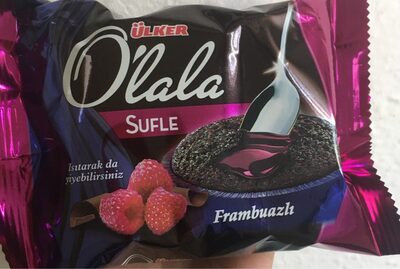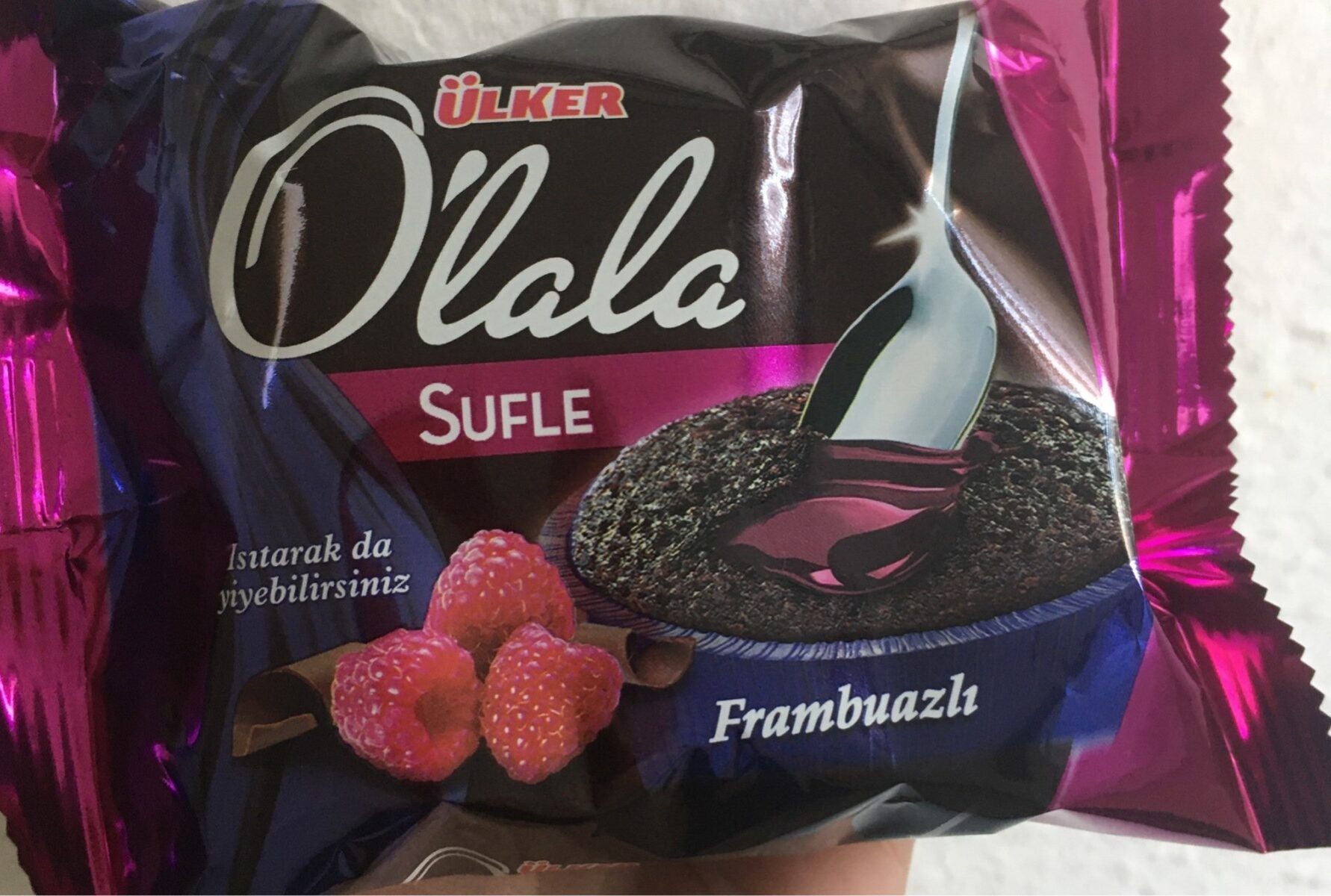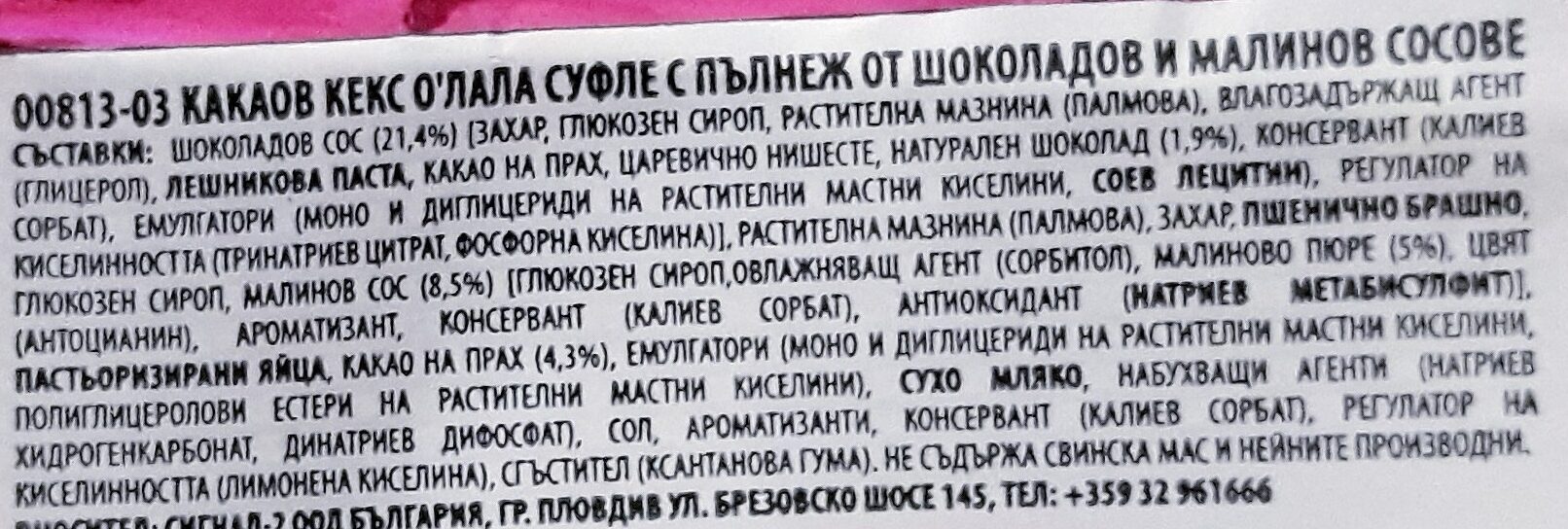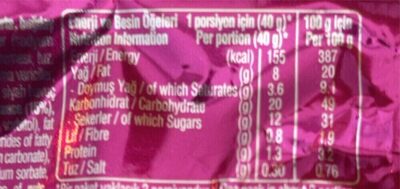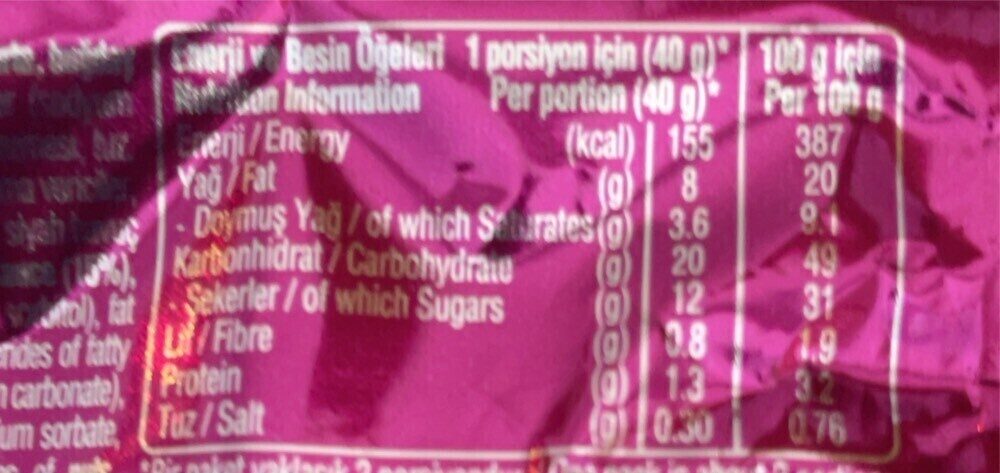Gıda şeffaflığını bir norm haline getirmemize yardımcı olun!
Kâr amacı gütmeyen bir kuruluş olarak, dünyanın dört bir yanındaki tüketicileri ne yedikleri konusunda bilgilendirmeye devam etmek için bağışlarınıza güveniyoruz.
Gıda devrimi sizinle başlıyor!
O'lala sufle frambuazli - Ülker - 70 g
O'lala sufle frambuazli - Ülker - 70 g
Bu ürün sayfası tamamlanmadı. Düzenleyerek ve elimizdeki fotoğraflardan daha fazla veri ekleyerek, ya da Android veya iPhone/iPad uygulamalarını kullanarak daha fazla fotoğraf çekerek tamamlanmasına yardım edebilirsiniz. Teşekkürler!
×
Barkod: 8690504081333 (EAN / EAN-13)
Miktar: 70 g
Ambalaj: en:Film
Markalar: Ülker
Kategoriler: Atıştırmalıklar, en:Sweet snacks, Bisküviler ve kekler, Kek, en:Chocolate cakes, en:Brownies, bg:Суфле, en:Десерт
Satılan ülkeler: Bulgaristan, Fransa, Türkiye
Tercihlerinizle eşleştirme
Sağlık
İçindekiler
-
54 bileşen
Bulgarca: ШОКОЛАДОВ СОС (21,4%) (ЗАХАР, ГЛЮКОЗЕН СИРОП, РАСТИТЕЛНА МАЗНИНА (ПАЛМОВА), ВЛАГОЗАДЪРЖАЩ АГЕНТ (ГЛИЦЕРОЛ), ЛЕШНИКОВА ПАСТА, КАКАО НА ПРАХ, ЦАРЕВИЧНО НИШЕСТЕ, НАТУРАЛЕН ШОКОЛАД (1,9%), ХОНСЕРВАНТ (КАЛИЕВ СОРБАТ), ЕМУЛГАТОРИ (МОНО И ДИГЛИЦЕРИДИ НА РАСТИТЕЛНИ МАСТНИ КИСЕЛИНИ, СОЕВ ЛЕЦИТИИ), РЕГУЛАТОР НА КИСЕЛИННОСТТА (ТРИНАТРИЕВ ЦИТРАТ, ФОСФОРНА КИСЕЛИНА)], РАСТИТЕЛНА МАЗНИНА (ПАЛМОВА), ЗАХАР, ЛШЕНИЧНО БРАШНО, ГЛЮКОЗЕН СИРОП, МАЛИНОВ СОС (8,5%) (ГЛЮКОЗЕН СИРОП, ОВЛАЖНЯВАЩ АГЕНТ (СОРБИТОЛ), МАЛИНОВО ПЮРЕ (5%), ЦВЯТ (АНТОЦИАНИН), АРОМАТИЗАНТ, КОНСЕРВАНТ (КАЛИЕВ СОРБАТ), АНТИОКСИДАНТ (НАТРИЕВ МЕТАБИСУЛокт)]. ПАСТЬОРИЗИРАНИ ЯЙЦА, КАКАО НА ПРАХ (4,3%), ЕМУЛГАТОРИ (МОНО И ДИГЛИЦЕРИДИ НА РАСТИТЕЛНИ МАСТНИ КИСЕЛИНИ, ПОЛИГЛИЦЕРОЛОВИ ЕСТЕРИ НА РАСТИТЕЛНИ МАСТНИ КИСЕЛИНИ), СУХО МЛЯКО, НАБУХВАЩИ АГЕНТИ (НАТРИЕВ ХИДРОГЕНКАРБОНАТ, ДИНАТРИЕВ ДИФОСФАТ), СОЛ, АРОМАТИЗАНТИ, КОНСЕРВАНТ (КАЛИЕВ СОРБАП), РЕГУЛАТОР НА КИСЕЛИННОСТТА (ЛИМОНЕНА КИСЕЛИНА), СГЪСТИТЕЛ (КСАНТАНОВА ГУМА). НЕ СЪДЪРЖА СВИНСКА МАС И НЕЙНИТЕ ПРОИЗВОДНи.Alerjenler: en:Milk, en:Nuts
Gıda işleme
-
Üst düzey işlemden geçmiş yiyecekler
Ürünün Çok işlenmiş gıdalar grubunda olduğunu gösteren unsurlar:
- Katkı maddesi: E163 - Antosiyanin
- Katkı maddesi: E415 - Ksantan zamkı
- Katkı maddesi: E420 - Sorbitol
- Katkı maddesi: E422 - Gliserin
- Katkı maddesi: E450
- Bileşen: Emulsifier
- Bileşen: Flavouring
- Bileşen: Glukoz
- Bileşen: Glikoz şurubu
- Bileşen: Humectant
- Bileşen: Thickener
Gıda ürünleri işlenme derecelerine göre 4 gruba ayrılır:
- İşlenmemiş veya az işlenmiş gıdalar
- İşlenmiş yemek malzemeleri
- İşlenmiş gıdalar
- Üst düzey işlemden geçmiş yiyecekler
Grubun belirlenmesi, ürünün kategorisine ve içerdiği bileşenlere göre yapılır.
Katkı maddeleri
-
E163 - Antosiyanin
Anthocyanin: Anthocyanins -also anthocyans; from Greek: ἄνθος -anthos- "flower" and κυάνεος/κυανοῦς kyaneos/kyanous "dark blue"- are water-soluble vacuolar pigments that, depending on their pH, may appear red, purple, or blue. Food plants rich in anthocyanins include the blueberry, raspberry, black rice, and black soybean, among many others that are red, blue, purple, or black. Some of the colors of autumn leaves are derived from anthocyanins.Anthocyanins belong to a parent class of molecules called flavonoids synthesized via the phenylpropanoid pathway. They occur in all tissues of higher plants, including leaves, stems, roots, flowers, and fruits. Anthocyanins are derived from anthocyanidins by adding sugars. They are odorless and moderately astringent. Although approved to color foods and beverages in the European Union, anthocyanins are not approved for use as a food additive because they have not been verified as safe when used as food or supplement ingredients. There is no conclusive evidence anthocyanins have any effect on human biology or diseases.Bilgi Kaynağı: Wikipedia (İngilizce)
-
E202 - Potasyum sorbat
Potassium sorbate: Potassium sorbate is the potassium salt of sorbic acid, chemical formula CH3CH=CH−CH=CH−CO2K. It is a white salt that is very soluble in water -58.2% at 20 °C-. It is primarily used as a food preservative -E number 202-. Potassium sorbate is effective in a variety of applications including food, wine, and personal-care products. While sorbic acid is naturally occurring in some berries, virtually all of the world's production of sorbic acid, from which potassium sorbate is derived, is manufactured synthetically.Bilgi Kaynağı: Wikipedia (İngilizce)
-
E330 - Sitrik asit
Citric acid: Citric acid is a weak organic acid that has the chemical formula C6H8O7. It occurs naturally in citrus fruits. In biochemistry, it is an intermediate in the citric acid cycle, which occurs in the metabolism of all aerobic organisms. More than a million tons of citric acid are manufactured every year. It is used widely as an acidifier, as a flavoring and chelating agent.A citrate is a derivative of citric acid; that is, the salts, esters, and the polyatomic anion found in solution. An example of the former, a salt is trisodium citrate; an ester is triethyl citrate. When part of a salt, the formula of the citrate ion is written as C6H5O3−7 or C3H5O-COO-3−3.Bilgi Kaynağı: Wikipedia (İngilizce)
-
E331
Sodium citrate: Sodium citrate may refer to any of the sodium salts of citrate -though most commonly the third-: Monosodium citrate Disodium citrate Trisodium citrateThe three forms of the salt are collectively known by the E number E331. Sodium citrates are used as acidity regulators in food and drinks, and also as emulsifiers for oils. They enable cheeses to melt without becoming greasy.Bilgi Kaynağı: Wikipedia (İngilizce)
-
E331iii
Sodium citrate: Sodium citrate may refer to any of the sodium salts of citrate -though most commonly the third-: Monosodium citrate Disodium citrate Trisodium citrateThe three forms of the salt are collectively known by the E number E331. Sodium citrates are used as acidity regulators in food and drinks, and also as emulsifiers for oils. They enable cheeses to melt without becoming greasy.Bilgi Kaynağı: Wikipedia (İngilizce)
-
E338 - Fosforik asit
Phosphoric acid: Phosphoric acid -also known as orthophosphoric acid or phosphoricV acid- is a weak acid with the chemical formula H3PO4. Orthophosphoric acid refers to phosphoric acid, which is the IUPAC name for this compound. The prefix ortho- is used to distinguish the acid from related phosphoric acids, called polyphosphoric acids. Orthophosphoric acid is a non-toxic acid, which, when pure, is a solid at room temperature and pressure. The conjugate base of phosphoric acid is the dihydrogen phosphate ion, H2PO−4, which in turn has a conjugate base of hydrogen phosphate, HPO2−4, which has a conjugate base of phosphate, PO3−4. Phosphates are essential for life.The most common source of phosphoric acid is an 85% aqueous solution; such solutions are colourless, odourless, and non-volatile. The 85% solution is a syrupy liquid, but still pourable. Although phosphoric acid does not meet the strict definition of a strong acid, the 85% solution is acidic enough to be corrosive. Because of the high percentage of phosphoric acid in this reagent, at least some of the orthophosphoric acid is condensed into polyphosphoric acids; for the sake of labeling and simplicity, the 85% represents H3PO4 as if it were all in the ortho form. Dilute aqueous solutions of phosphoric acid exist in the ortho form.Bilgi Kaynağı: Wikipedia (İngilizce)
-
E415 - Ksantan zamkı
Xanthan gum: Xanthan gum -- is a polysaccharide with many industrial uses, including as a common food additive. It is an effective thickening agent and stabilizer to prevent ingredients from separating. It can be produced from simple sugars using a fermentation process, and derives its name from the species of bacteria used, Xanthomonas campestris.Bilgi Kaynağı: Wikipedia (İngilizce)
-
E420 - Sorbitol
Sorbitol: Sorbitol --, less commonly known as glucitol --, is a sugar alcohol with a sweet taste which the human body metabolizes slowly. It can be obtained by reduction of glucose, which changes the aldehyde group to a hydroxyl group. Most sorbitol is made from corn syrup, but it is also found in nature, for example in apples, pears, peaches, and prunes. It is converted to fructose by sorbitol-6-phosphate 2-dehydrogenase. Sorbitol is an isomer of mannitol, another sugar alcohol; the two differ only in the orientation of the hydroxyl group on carbon 2. While similar, the two sugar alcohols have very different sources in nature, melting points, and uses.Bilgi Kaynağı: Wikipedia (İngilizce)
-
E422 - Gliserin
Glycerol: Glycerol -; also called glycerine or glycerin; see spelling differences- is a simple polyol compound. It is a colorless, odorless, viscous liquid that is sweet-tasting and non-toxic. The glycerol backbone is found in all lipids known as triglycerides. It is widely used in the food industry as a sweetener and humectant and in pharmaceutical formulations. Glycerol has three hydroxyl groups that are responsible for its solubility in water and its hygroscopic nature.Bilgi Kaynağı: Wikipedia (İngilizce)
-
E500
Sodium carbonate: Sodium carbonate, Na2CO3, -also known as washing soda, soda ash and soda crystals, and in the monohydrate form as crystal carbonate- is the water-soluble sodium salt of carbonic acid. It most commonly occurs as a crystalline decahydrate, which readily effloresces to form a white powder, the monohydrate. Pure sodium carbonate is a white, odorless powder that is hygroscopic -absorbs moisture from the air-. It has a strongly alkaline taste, and forms a moderately basic solution in water. Sodium carbonate is well known domestically for its everyday use as a water softener. Historically it was extracted from the ashes of plants growing in sodium-rich soils, such as vegetation from the Middle East, kelp from Scotland and seaweed from Spain. Because the ashes of these sodium-rich plants were noticeably different from ashes of timber -used to create potash-, they became known as "soda ash". It is synthetically produced in large quantities from salt -sodium chloride- and limestone by a method known as the Solvay process. The manufacture of glass is one of the most important uses of sodium carbonate. Sodium carbonate acts as a flux for silica, lowering the melting point of the mixture to something achievable without special materials. This "soda glass" is mildly water-soluble, so some calcium carbonate is added to the melt mixture to make the glass produced insoluble. This type of glass is known as soda lime glass: "soda" for the sodium carbonate and "lime" for the calcium carbonate. Soda lime glass has been the most common form of glass for centuries. Sodium carbonate is also used as a relatively strong base in various settings. For example, it is used as a pH regulator to maintain stable alkaline conditions necessary for the action of the majority of photographic film developing agents. It acts as an alkali because when dissolved in water, it dissociates into the weak acid: carbonic acid and the strong alkali: sodium hydroxide. This gives sodium carbonate in solution the ability to attack metals such as aluminium with the release of hydrogen gas.It is a common additive in swimming pools used to raise the pH which can be lowered by chlorine tablets and other additives which contain acids. In cooking, it is sometimes used in place of sodium hydroxide for lyeing, especially with German pretzels and lye rolls. These dishes are treated with a solution of an alkaline substance to change the pH of the surface of the food and improve browning. In taxidermy, sodium carbonate added to boiling water will remove flesh from the bones of animal carcasses for trophy mounting or educational display. In chemistry, it is often used as an electrolyte. Electrolytes are usually salt-based, and sodium carbonate acts as a very good conductor in the process of electrolysis. In addition, unlike chloride ions, which form chlorine gas, carbonate ions are not corrosive to the anodes. It is also used as a primary standard for acid-base titrations because it is solid and air-stable, making it easy to weigh accurately.Bilgi Kaynağı: Wikipedia (İngilizce)
-
E500ii - Sodyum bikarbonat
Sodium carbonate: Sodium carbonate, Na2CO3, -also known as washing soda, soda ash and soda crystals, and in the monohydrate form as crystal carbonate- is the water-soluble sodium salt of carbonic acid. It most commonly occurs as a crystalline decahydrate, which readily effloresces to form a white powder, the monohydrate. Pure sodium carbonate is a white, odorless powder that is hygroscopic -absorbs moisture from the air-. It has a strongly alkaline taste, and forms a moderately basic solution in water. Sodium carbonate is well known domestically for its everyday use as a water softener. Historically it was extracted from the ashes of plants growing in sodium-rich soils, such as vegetation from the Middle East, kelp from Scotland and seaweed from Spain. Because the ashes of these sodium-rich plants were noticeably different from ashes of timber -used to create potash-, they became known as "soda ash". It is synthetically produced in large quantities from salt -sodium chloride- and limestone by a method known as the Solvay process. The manufacture of glass is one of the most important uses of sodium carbonate. Sodium carbonate acts as a flux for silica, lowering the melting point of the mixture to something achievable without special materials. This "soda glass" is mildly water-soluble, so some calcium carbonate is added to the melt mixture to make the glass produced insoluble. This type of glass is known as soda lime glass: "soda" for the sodium carbonate and "lime" for the calcium carbonate. Soda lime glass has been the most common form of glass for centuries. Sodium carbonate is also used as a relatively strong base in various settings. For example, it is used as a pH regulator to maintain stable alkaline conditions necessary for the action of the majority of photographic film developing agents. It acts as an alkali because when dissolved in water, it dissociates into the weak acid: carbonic acid and the strong alkali: sodium hydroxide. This gives sodium carbonate in solution the ability to attack metals such as aluminium with the release of hydrogen gas.It is a common additive in swimming pools used to raise the pH which can be lowered by chlorine tablets and other additives which contain acids. In cooking, it is sometimes used in place of sodium hydroxide for lyeing, especially with German pretzels and lye rolls. These dishes are treated with a solution of an alkaline substance to change the pH of the surface of the food and improve browning. In taxidermy, sodium carbonate added to boiling water will remove flesh from the bones of animal carcasses for trophy mounting or educational display. In chemistry, it is often used as an electrolyte. Electrolytes are usually salt-based, and sodium carbonate acts as a very good conductor in the process of electrolysis. In addition, unlike chloride ions, which form chlorine gas, carbonate ions are not corrosive to the anodes. It is also used as a primary standard for acid-base titrations because it is solid and air-stable, making it easy to weigh accurately.Bilgi Kaynağı: Wikipedia (İngilizce)
Malzeme analizi
-
Hurma yağı
Hurma yağı içeren malzemeler: en:Palm, en:Palm
-
Vegan değil
Vegan olmayan malzemeler: Yumurta, Süt tozuBazı içerikler tanınamadı.
Yardımına ihtiyacımız var!
Aşağıdakileri yaparak daha fazla bileşeni tanımamıza ve bu ürün ve diğerlerinin içerik listesini daha iyi analiz etmemize yardımcı olabilirsiniz:
- İçindekiler listesindeki yazım hatalarını düzeltmek ve/veya malzemelerle ilgili olmayan diğer dillerde ve cümlelerde malzemeleri kaldırmak için bu ürün sayfasını düzenleyin.
- Çok dilli içerik listelerimize, içerik işleme yöntemlerine ve etiketlere yeni girişler, eşanlamlı kelimeler veya çeviriler ekleyin.
Eğer yardımcı olmak isterseniz, #ingredients kanalımıza Slack tartışma alanımız üzerinden katılın ve/veya Wiki'miz üzerinden içerik analizini öğrenin. Teşekkürler!
-
Vejetaryen durumu bilinmiyor
Tanınmayan içerikler: bg:шоколадов-сос, bg:натурален-шоколад, bg:хонсервант, bg:моно-и-диглицериди-на-растителни-мастни-киселини, bg:соев-лецитии, bg:лшенично-брашно, bg:малинов-сос, bg:овлажняващ-агент, bg:малиново-пюре, bg:цвят, bg:натриев-метабисулокт, bg:моно-и-диглицериди-на-растителни-мастни-киселини, bg:полиглицеролови-естери-на-растителни-мастни-киселини, bg:набухващи-агенти, bg:калиев-сорбап, bg:не-съдържа-свинска-мас-и-нейните-производниBazı içerikler tanınamadı.
Yardımına ihtiyacımız var!
Aşağıdakileri yaparak daha fazla bileşeni tanımamıza ve bu ürün ve diğerlerinin içerik listesini daha iyi analiz etmemize yardımcı olabilirsiniz:
- İçindekiler listesindeki yazım hatalarını düzeltmek ve/veya malzemelerle ilgili olmayan diğer dillerde ve cümlelerde malzemeleri kaldırmak için bu ürün sayfasını düzenleyin.
- Çok dilli içerik listelerimize, içerik işleme yöntemlerine ve etiketlere yeni girişler, eşanlamlı kelimeler veya çeviriler ekleyin.
Eğer yardımcı olmak isterseniz, #ingredients kanalımıza Slack tartışma alanımız üzerinden katılın ve/veya Wiki'miz üzerinden içerik analizini öğrenin. Teşekkürler!
-
İçerik analizlerinin detayları
Yardımına ihtiyacımız var!
Bazı içerikler tanınamadı.
Yardımına ihtiyacımız var!
Aşağıdakileri yaparak daha fazla bileşeni tanımamıza ve bu ürün ve diğerlerinin içerik listesini daha iyi analiz etmemize yardımcı olabilirsiniz:
- İçindekiler listesindeki yazım hatalarını düzeltmek ve/veya malzemelerle ilgili olmayan diğer dillerde ve cümlelerde malzemeleri kaldırmak için bu ürün sayfasını düzenleyin.
- Çok dilli içerik listelerimize, içerik işleme yöntemlerine ve etiketlere yeni girişler, eşanlamlı kelimeler veya çeviriler ekleyin.
Eğer yardımcı olmak isterseniz, #ingredients kanalımıza Slack tartışma alanımız üzerinden katılın ve/veya Wiki'miz üzerinden içerik analizini öğrenin. Teşekkürler!
bg: ШОКОЛАДОВ СОС 21.4%, ЗАХАР, ГЛЮКОЗЕН СИРОП, РАСТИТЕЛНА МАЗНИНА (ПАЛМОВА), ВЛАГОЗАДЪРЖАЩ АГЕНТ (ГЛИЦЕРОЛ), ЛЕШНИКОВА ПАСТА, КАКАО НА ПРАХ, ЦАРЕВИЧНО НИШЕСТЕ, НАТУРАЛЕН ШОКОЛАД 1.9%, ХОНСЕРВАНТ (КАЛИЕВ СОРБАТ), ЕМУЛГАТОРИ (МОНО И ДИГЛИЦЕРИДИ НА РАСТИТЕЛНИ МАСТНИ КИСЕЛИНИ, СОЕВ ЛЕЦИТИИ), РЕГУЛАТОР НА КИСЕЛИННОСТТА (ТРИНАТРИЕВ ЦИТРАТ, ФОСФОРНА КИСЕЛИНА), РАСТИТЕЛНА МАЗНИНА (ПАЛМОВА), ЗАХАР, ЛШЕНИЧНО БРАШНО, ГЛЮКОЗЕН СИРОП, МАЛИНОВ СОС 8.5%, ГЛЮКОЗЕН СИРОП, ОВЛАЖНЯВАЩ АГЕНТ (СОРБИТОЛ), МАЛИНОВО ПЮРЕ 5%, ЦВЯТ (АНТОЦИАНИН), АРОМАТИЗАНТ, КОНСЕРВАНТ (КАЛИЕВ СОРБАТ), АНТИОКСИДАНТ (НАТРИЕВ МЕТАБИСУЛокт), ЯЙЦА, КАКАО НА ПРАХ 4.3%, ЕМУЛГАТОРИ (МОНО И ДИГЛИЦЕРИДИ НА РАСТИТЕЛНИ МАСТНИ КИСЕЛИНИ, ПОЛИГЛИЦЕРОЛОВИ ЕСТЕРИ НА РАСТИТЕЛНИ МАСТНИ КИСЕЛИНИ), СУХО МЛЯКО, НАБУХВАЩИ АГЕНТИ (НАТРИЕВ ХИДРОГЕНКАРБОНАТ, ДИНАТРИЕВ ДИФОСФАТ), СОЛ, АРОМАТИЗАНТИ, КОНСЕРВАНТ (КАЛИЕВ СОРБАП), РЕГУЛАТОР НА КИСЕЛИННОСТТА (ЛИМОНЕНА КИСЕЛИНА), СГЪСТИТЕЛ (КСАНТАНОВА ГУМА), НЕ СЪДЪРЖА СВИНСКА МАС И НЕЙНИТЕ ПРОИЗВОДНи- ШОКОЛАДОВ СОС -> bg:шоколадов-сос - percent: 21.4
- ЗАХАР -> en:sugar - vegan: yes - vegetarian: yes - ciqual_proxy_food_code: 31016
- ГЛЮКОЗЕН СИРОП -> en:glucose-syrup - vegan: yes - vegetarian: yes - ciqual_proxy_food_code: 31016
- РАСТИТЕЛНА МАЗНИНА -> en:vegetable-fat - vegan: yes - vegetarian: yes - from_palm_oil: maybe
- ПАЛМОВА -> en:palm - vegan: yes - vegetarian: yes - from_palm_oil: yes - ciqual_food_code: 16129
- ВЛАГОЗАДЪРЖАЩ АГЕНТ -> en:humectant
- ГЛИЦЕРОЛ -> en:e422 - vegan: maybe - vegetarian: maybe
- ЛЕШНИКОВА ПАСТА -> en:hazelnut-paste - vegan: yes - vegetarian: yes - ciqual_food_code: 15004
- КАКАО НА ПРАХ -> en:cocoa-powder - vegan: yes - vegetarian: yes - ciqual_food_code: 18100
- ЦАРЕВИЧНО НИШЕСТЕ -> en:corn-starch - vegan: yes - vegetarian: yes - ciqual_food_code: 9510
- НАТУРАЛЕН ШОКОЛАД -> bg:натурален-шоколад - percent: 1.9
- ХОНСЕРВАНТ -> bg:хонсервант
- КАЛИЕВ СОРБАТ -> en:e202 - vegan: yes - vegetarian: yes
- ЕМУЛГАТОРИ -> en:emulsifier
- МОНО И ДИГЛИЦЕРИДИ НА РАСТИТЕЛНИ МАСТНИ КИСЕЛИНИ -> bg:моно-и-диглицериди-на-растителни-мастни-киселини
- СОЕВ ЛЕЦИТИИ -> bg:соев-лецитии
- РЕГУЛАТОР НА КИСЕЛИННОСТТА -> en:acidity-regulator
- ТРИНАТРИЕВ ЦИТРАТ -> en:e331iii - vegan: yes - vegetarian: yes
- ФОСФОРНА КИСЕЛИНА -> en:e338 - vegan: yes - vegetarian: yes
- РАСТИТЕЛНА МАЗНИНА -> en:vegetable-fat - vegan: yes - vegetarian: yes - from_palm_oil: maybe
- ПАЛМОВА -> en:palm - vegan: yes - vegetarian: yes - from_palm_oil: yes - ciqual_food_code: 16129
- ЗАХАР -> en:sugar - vegan: yes - vegetarian: yes - ciqual_proxy_food_code: 31016
- ЛШЕНИЧНО БРАШНО -> bg:лшенично-брашно
- ГЛЮКОЗЕН СИРОП -> en:glucose-syrup - vegan: yes - vegetarian: yes - ciqual_proxy_food_code: 31016
- МАЛИНОВ СОС -> bg:малинов-сос - percent: 8.5
- ГЛЮКОЗЕН СИРОП -> en:glucose-syrup - vegan: yes - vegetarian: yes - ciqual_proxy_food_code: 31016
- ОВЛАЖНЯВАЩ АГЕНТ -> bg:овлажняващ-агент
- СОРБИТОЛ -> en:e420 - vegan: yes - vegetarian: yes
- МАЛИНОВО ПЮРЕ -> bg:малиново-пюре - percent: 5
- ЦВЯТ -> bg:цвят
- АНТОЦИАНИН -> en:e163 - vegan: yes - vegetarian: yes
- АРОМАТИЗАНТ -> en:flavouring - vegan: maybe - vegetarian: maybe
- КОНСЕРВАНТ -> en:preservative
- КАЛИЕВ СОРБАТ -> en:e202 - vegan: yes - vegetarian: yes
- АНТИОКСИДАНТ -> en:antioxidant
- НАТРИЕВ МЕТАБИСУЛокт -> bg:натриев-метабисулокт
- ЯЙЦА -> en:egg - vegan: no - vegetarian: yes - ciqual_food_code: 22000
- КАКАО НА ПРАХ -> en:cocoa-powder - vegan: yes - vegetarian: yes - ciqual_food_code: 18100 - percent: 4.3
- ЕМУЛГАТОРИ -> en:emulsifier
- МОНО И ДИГЛИЦЕРИДИ НА РАСТИТЕЛНИ МАСТНИ КИСЕЛИНИ -> bg:моно-и-диглицериди-на-растителни-мастни-киселини
- ПОЛИГЛИЦЕРОЛОВИ ЕСТЕРИ НА РАСТИТЕЛНИ МАСТНИ КИСЕЛИНИ -> bg:полиглицеролови-естери-на-растителни-мастни-киселини
- СУХО МЛЯКО -> en:milk-powder - vegan: no - vegetarian: yes - ciqual_proxy_food_code: 19044
- НАБУХВАЩИ АГЕНТИ -> bg:набухващи-агенти
- НАТРИЕВ ХИДРОГЕНКАРБОНАТ -> en:e500ii - vegan: yes - vegetarian: yes
- ДИНАТРИЕВ ДИФОСФАТ -> en:e450i - vegan: yes - vegetarian: yes
- СОЛ -> en:salt - vegan: yes - vegetarian: yes - ciqual_food_code: 11058
- АРОМАТИЗАНТИ -> en:flavouring - vegan: maybe - vegetarian: maybe
- КОНСЕРВАНТ -> en:preservative
- КАЛИЕВ СОРБАП -> bg:калиев-сорбап
- РЕГУЛАТОР НА КИСЕЛИННОСТТА -> en:acidity-regulator
- ЛИМОНЕНА КИСЕЛИНА -> en:e330 - vegan: yes - vegetarian: yes
- СГЪСТИТЕЛ -> en:thickener
- КСАНТАНОВА ГУМА -> en:e415 - vegan: yes - vegetarian: yes
- НЕ СЪДЪРЖА СВИНСКА МАС И НЕЙНИТЕ ПРОИЗВОДНи -> bg:не-съдържа-свинска-мас-и-нейните-производни
Beslenme
-
Ortalama beslenme kalitesi
⚠ ️Uyarı: Meyve, sebze ve kuruyemiş miktarı etikette belirtilmemiştir, içindekiler listesinden tahmin edilmiştir: 2Bu ürün, Nutri-Score hesaplaması için bir içecek kabul edilmemektedir.
Pozitif puanlar: 0
- Proteinler: 0 / 5 (değer: 1.3, yuvarlanmış değer: 1.3)
- Lif: 0 / 5 (değer: 0.8, yuvarlanmış değer: 0.8)
- Meyve, sebze, kuruyemiş ve kolza/ceviz/ zeytin yağı: 0 / 5 (değer: 2.45625, yuvarlanmış değer: 2.5)
Negatif puanlar: 7
- Enerji: 1 / 10 (değer: 649, yuvarlanmış değer: 649)
- Şeker: 2 / 10 (değer: 12, yuvarlanmış değer: 12)
- Doymuş yağ: 3 / 10 (değer: 3.6, yuvarlanmış değer: 3.6)
- Sodyum: 1 / 10 (değer: 120, yuvarlanmış değer: 120)
Negatif puanlar 11'den az olduğu için proteinler için olan puanlar dahil edildi.
Beslenme puanı: (7 - 0)
Nutri-Score:
-
Besin seviyeleri
-
Yağ içinde orta miktar (8%)
Bilmeniz gerekenler- Yüksek yağ tüketimi, özellikle doymuş yağlar, kalp hastalığı riskini artıran kolesterolü yükseltebilir.
Öneri: Yağ ve doymuş yağ tüketimini azaltın- Daha az yağ ve doymuş yağ içeriği olan ürünleri seçin.
Bilgi Kaynağı: National Health Service UK (NHS) - Fat: the facts
-
Saturated fat içinde orta miktar (3.6%)
Bilmeniz gerekenler- Yüksek yağ tüketimi, özellikle doymuş yağlar, kalp hastalığı riskini artıran kolesterolü yükseltebilir.
Öneri: Yağ ve doymuş yağ tüketimini azaltın- Daha az yağ ve doymuş yağ içeriği olan ürünleri seçin.
Bilgi Kaynağı: National Health Service UK (NHS) - Fat: the facts
-
Şeker içinde orta miktar (12%)
Bilmeniz gerekenler- Yüksek şeker tüketimi kilo alımına ve diş çürümelerine neden olabilir. Aynı zamanda tip 2 diyabet ve kardiyovasküler hastalık riskini artırır.
Öneri: Şeker ve şekerli içeceklerin tüketimini sınırlayın- Şekerli içecekler (gazlı içecekler, meyveli içecekler, meyve suları ve nektarlar gibi) mümkün olduğu kadar sınırlandırılmalıdır (günde 1 bardaktan fazla olmamalıdır).
- Şeker oranı düşük ürünleri tercih edin ve ilave şeker içeren ürünlerin tüketimini azaltın.
Bilgi Kaynağı: National Health Service UK (NHS) - Sugar: the facts
-
Yemek tuzu içinde orta miktar (0.3%)
Bilmeniz gerekenler- Yüksek miktarda tuz (veya sodyum) tüketimi, kalp hastalığı ve felç riskini artırabilen kan basıncının yükselmesine neden olabilir.
- Yüksek tansiyonu olan birçok kişi sahip olduğunu bilmiyor çünkü çoğunlukla hiçbir belirtisi olmuyor.
- Çoğu insan çok fazla tuz tüketir (günde ortalama 9 ila 12 gram), bu da önerilen maksimum alım seviyesinin yaklaşık iki katıdır.
Öneri: Tuz ve tuzlu yiyecek tüketimini sınırlayın- Yemek pişirirken kullanılan tuz miktarını azaltın ve sofrada bir daha tuz atmayın.
- Tuzlu atıştırmalıkların tüketimini sınırlayın ve daha az tuz içeren ürünleri seçin.
Bilgi Kaynağı: National Health Service UK (NHS) - Salt: the facts
-
-
Beslenme gerçekleri
Beslenme gerçekleri Satıldığı gibi
100 g / 100 ml içinSatıldığı gibi
porsiyon başına (70g)Nazaran: Kek Enerji 649 kj
(155 kcal)454 kj
(108 kcal)Yağ 8 g 5,6 g Saturated fat 3,6 g 2,52 g Karbonhidratlar 20 g 14 g Şeker 12 g 8,4 g Fiber 0,8 g 0,56 g Protein 1,3 g 0,91 g Yemek tuzu 0,3 g 0,21 g Fruits‚ vegetables‚ nuts and rapeseed‚ walnut and olive oils (estimate from ingredients list analysis) 2,456 % 2,456 %
Çevre
-
Eco-Score E - Çok yüksek çevresel etki
Eco-Score gıda ürünlerinin çevresel etkilerini özetleyen deneysel bir puandır.→ Eco-Score başlangıçta Fransa için geliştirildi ve diğer Avrupa ülkelerine de yayılıyor. Eco-Score formülü, her ülke için daha kesin ve daha uygun hale getirmek üzere düzenli olarak geliştirildiğinden değişebilir.Yaşam döngüsü analizi
-
Aynı kategorideki ürünlerin ortalama etkisi: C (Score: 44/100)
Kategori: Brownie (chocolate cake)
Kategori: Brownie (chocolate cake)
- PEF çevre puanı: 0.65 (puan ne kadar düşükse, etki o kadar düşük olur)
- iklim değişikliği üzerindeki etki dahil: 7.20 kg CO2 eşdeğeri/kg ürün
Sahne Etki Tarım
85.5 %İşleme
7.9 %Ambalaj
2.9 %Taşıma
3.0 %Dağıtım
0.7 %Tüketim
0.0 %
Bonuslar ve kötüye kullanımlar
-
İçeriklerin nereden olduğu bilgisi eksik
Malus: -5
⚠ ️ Bu ürünün bileşenlerinin kökenleri belirtilmemiştir.
Ambalaj üzerinde belirtilmişse, ürün sayfasını değiştirebilir ve ekleyebilirsiniz.
Bu ürünün üreticisi iseniz, üreticilere yönelik ücretsiz platformumuzlabize bilgi gönderebilirsiniz.
-
Türleri tehdit eden içerikler içerir
Malus: -10
Hurma yağı içerir
Asya, Afrika ve Latin Amerika'daki tropik ormanlar, palmiye ağacı tarlaları oluşturmak ve genişletmek için yok ediliyor. Ormansızlaşma iklim değişikliğine katkıda bulunuyor ve orangutan, pigme fil ve Sumatra gergedanı gibi türleri tehlikeye atıyor.
-
Bu ürün için eksik paketleme bilgisi
Malus: -15
⚠ ️ Bu ürünün ambalaj bilgileri doldurulmamıştır.⚠ ️ Eco-Score'un daha doğru hesaplanması için ürün sayfasını düzenleyebilir ve ekleme yapabilirsiniz.
Bu ürünün üreticisi iseniz, üreticilere yönelik ücretsiz platformumuzlabize bilgi gönderebilirsiniz.
Bu ürün için Eko-Skor
-
Bu ürün için etki: E (Score: 14/100)
Ürün: O'lala sufle frambuazli - Ülker - 70 g
Yaşam döngüsü analizi puanı: 44
Bonusların ve kötü kullanımların toplamı: -30
Son skor: 14/100
-
Karbon Ayakizi
-
Benzinli bir arabayla 3.7 km gitmeye eşittir
100 g ürün başına 720 g CO²
karbon emisyonu sayısı ADEME'nin Agribalyse veritabanından aşağıdaki kategori için türetilmiştir: Brownie (chocolate cake) (Kaynak: ADEME Agribalyse Veritabanı)
Sahne Etki Tarım
88.0 %İşleme
4.8 %Ambalaj
4.0 %Taşıma
2.9 %Dağıtım
0.3 %Tüketim
0.0 %
Ambalaj
-
Bu ürün için eksik paketleme bilgisi
⚠ ️ Bu ürünün ambalaj bilgileri doldurulmamıştır.Geri dönüşüm bilgilerinin fotoğrafını çekin Geri dönüşüm bilgilerinin fotoğrafını çekin
Taşıma
-
Bileşenlerin kökenleri
İçeriklerin nereden olduğu bilgisi eksik
⚠ ️ Bu ürünün bileşenlerinin kökenleri belirtilmemiştir.
Ambalaj üzerinde belirtilmişse, ürün sayfasını değiştirebilir ve ekleyebilirsiniz.
Bu ürünün üreticisi iseniz, üreticilere yönelik ücretsiz platformumuzlabize bilgi gönderebilirsiniz.Bu ürün için bileşenlerin kökenlerini ekleyin Bu ürün için bileşenlerin kökenlerini ekleyin
Tehdit altındaki türler
-
Hurma yağı içerir
Ormansızlaşmaya neden olur ve orangutan gibi türleri tehdit eder
Asya, Afrika ve Latin Amerika'daki tropik ormanlar, palmiye ağacı tarlaları oluşturmak ve genişletmek için yok ediliyor. Ormansızlaşma iklim değişikliğine katkıda bulunuyor ve orangutan, pigme fil ve Sumatra gergedanı gibi türleri tehlikeye atıyor.
Report a problem
-
Incomplete or incorrect information?
Category, labels, ingredients, allergens, nutritional information, photos etc.
If the information does not match the information on the packaging, please complete or correct it. Open Food Facts is a collaborative database, and every contribution is useful for all.
Veri kaynakları
Üzerinde ürün eklendi tarafından kiliweb
Ürün sayfasının son düzenlemesi tarafından foodless.
Ürün sayfasını da düzenleyen ayyyvocado, openfoodfacts-contributors, packbot, roboto-app, trinkata, yuka.YVpJQ1RLWlJpZjQ3aDhGZzAwTHYzK2hLNElLa1ExdTNBdTRYSVE9PQ, yuka.sY2b0xO6T85zoF3NwEKvlmFdTMLPj2-bMBDWvRe3m4_XE7nwPt1bwarwbas.
